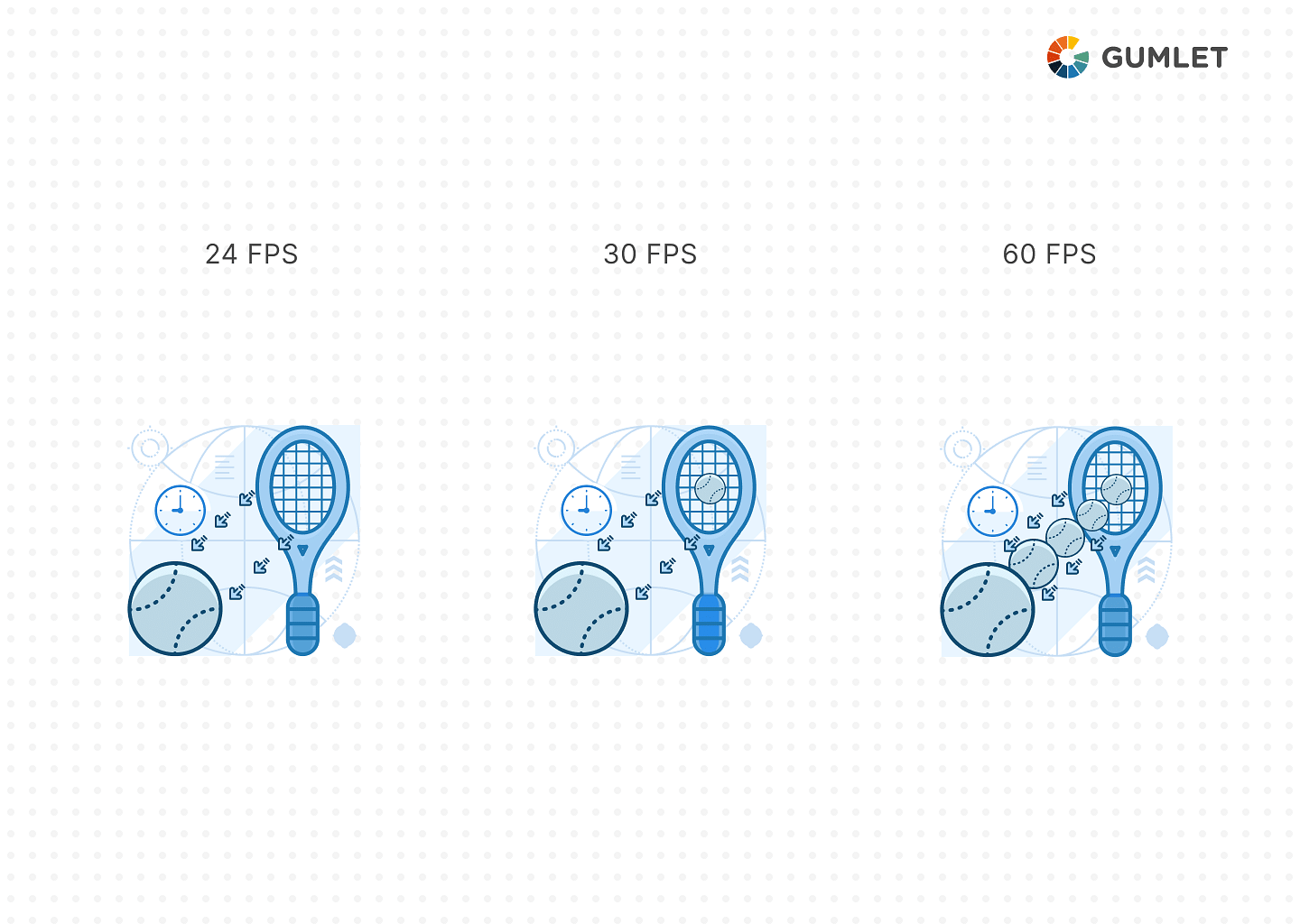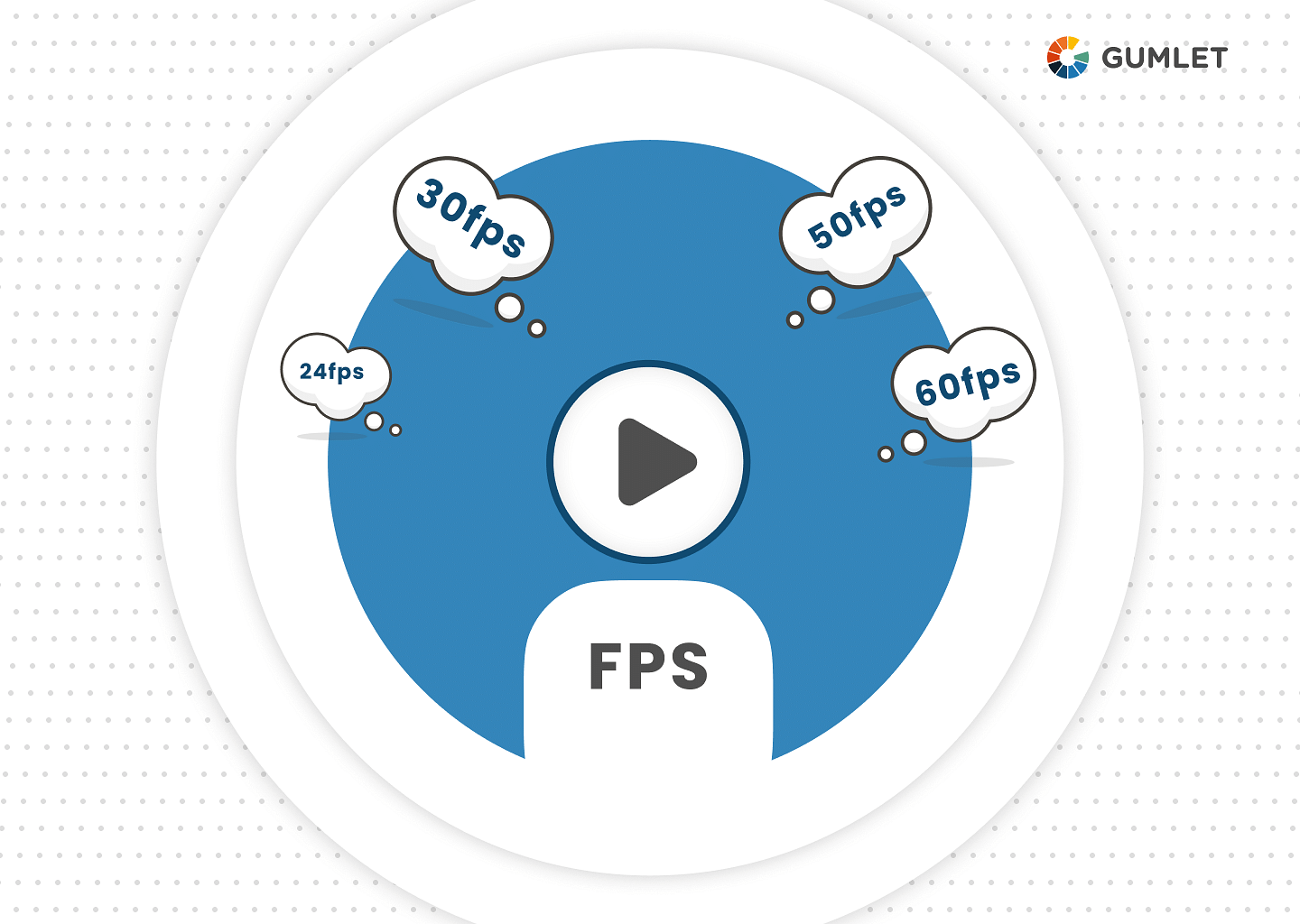Video content has slowly but surely become the norm, and businesses all around the globe are leveraging the benefits of this medium of communication. However, it might be intimidating for starters in the world of video production, especially in the presence of so many technical terms. One of these terms that often confuses people is ‘frame rate.’ In this article, we’ll tackle the ten most asked questions around video frame rate. By the end, you will have a complete understanding of what frame rate is, what are the different frame rates, and which frame rate is best for your cause.
1. What is video frame rate? (or) What is FPS?
Videos are essentially a sequence of still images that are viewed in an order and at a certain speed to give the appearance of animation or motion. Each of these independent images is what we call a frame. The frame rate can then be defined as the rate at which these images are shown to you on the screen. That is what is expressed in the form of frames per second (FPS). So, essentially, frame rate is the speed at which the frames are played in front of you, and the unit of measurement of that speed is FPS. So, if your video plays at, say, X FPS, it means that you see X distinct still images during every second of the video.
2. Different types of video frame rate?
There are different types of frame rates that you can choose from, depending on precisely what you want from your video. In essence, if your video shows too much detail, it might end up looking unnatural. Also, if you pick a frame rate that is very low, your video might look sloppy and may not provide a good user experience. That said, we are going to talk in-depth about all the different frame rates that you must know of, but before that, here’s a quick overview of the different types of frame rates:
- 24fps: This is the standard rate for TV shows as well as movies. This is also thought to be the minimum rate needed for capturing the video all the while maintaining realistic animations and motions. Generally, even if a video is captured at a higher rate, it is tuned down during production and displayed at 24fps too.
- 30fps: This is the second most opted-for frame rate when it comes to producing movies. This is preferred by producers who wish to display videos with a lot of motion. Since 30fps uses more frames per second, it is deemed good sports videos and other such videos that try to capture a lot of movement.
- 60+fps: In general, anything above 30fps is used for either recording video game footage or to create slow-motion video content. Many smartphones today come with the ability of capturing 60fps slow-motion videos too, thanks to the advancement in technology.
At this point, you must be wondering why exactly frame rate matters. Let’s answer that question in the next section.

3. Why does video frame rate matter?
You might have understood by now that frame rate takes care of the number of frames you see in a second. Clearly, this has a direct relation to the style of the video being produced, and in turn, to the viewing experience of the audience. Frame rates, then, matter a lot when you have to vary your audience’s viewing experiences while thinking of multiple things like:
- How realistic do you want your video to be?
- Do you plan on using techniques like slow-motion and all?
- What is the taste of your target audience?
- Which FPS will serve the best purpose for you?
For instance, most of the movies or TV shows that you see are generally displayed at 24fps, since that is reflective of how we see the world in our day-to-day lives, which makes the whole cinematic experience much more realistic. However, for sporting events or other such videos that are required to capture too much movement, higher frame rates are better since they keep the motion smooth while keeping all the details crisp. Likewise, the type of video you want to make decides the frame rate that you should go for, and in that context, frame rate matters a lot if you are to provide a satisfactory viewing experience to users.
4. Which is better, 60fps or 30fps
The core difference between these two frame rates, i.e. - 60fps and 30fps - is the number of frames that are offered on the screen per second. However, keep in mind that more frames do not always mean a good video, so there’s no clear-cut answer to the question - which is better, 60 or 30fps?
To get the answer in your context, you will need to understand what your requirements are from the video. Another thing to note is that the fewer frames a shot has, the less expensive it is to perform visual modifications on it and distribute it to your audience. Greater fps directly means greater details, which makes the scene look too plastic and unrealistic. That is the reason why most filmmakers keep their frame rate as 24 or 30, depending on their need.
On the flip side, 60fps is what you want to work with if you require more movement and need to slow down the shots that you have captured. Essentially, as a rule of thumb, if you require to capture fast and quick movements, it might be a good idea to go for 60fps frame rate.
5. Which frame rate is best for video?
As we have discussed so far, there is no objectively correct answer for this question. In essence, the frame rate that is best for your video will be the frame rate that really fits the purpose that you want to accomplish. If you are after slow-motion shots or quick movements, you might want 60 or more fps. However, if you want to shoot realistic videos that resemble real-life visuals, 30fps will serve you better.
6. Does frame rate affect video quality?
The video quality is dependent entirely on the resolution in which you record the video. So, frame rates have nothing to do with the quality of your video. In general, the greater your video resolution, the better will be the quality. Frame rates do impact the smoothness of your video, by taking care of the number of frames that are displayed per second, but they don’t have anything to do with the video quality per se.
7. Does frame rate affect video file size?
Any digital video that you encounter is essentially a series of images. These images change rapidly, which ends up giving you the illusion of motion. Frame rate, then, is the number of frames of images that are being displayed per second. As a result of this, the frame rate that you opt for is going to have a considerable impact on your final video file size. For instance, movies in theaters are shown at 24fps, whereas most television videos operate at 30fps. This difference is also visible in the file size difference between the two video files.
In essence, as a general rule of thumb, if you lower down your video frame rate by 10-15fps, you will see the file size reduced by 200% to 300%. However, you should also keep in mind that reducing the frame rate also has an impact on the smoothness of your video - which means, it impacts how your video will finally be rendered on your viewers’ devices. Therefore, the best practice is to experiment a bit and come to the acceptable frame rate as per your specific video clip at hand, which also keeps the file size as low as possible without disturbing the viewing experience in any way.
8. How to choose the frame rate for video streaming?
Your video frame rate will depend on exactly what it is that you are shooting. Keeping in mind video streaming, here are some of the frame rates that you can choose from, depending on your precise requirements.
24fps
- This is good for recording people speaking.
- Videos of landscapes or sceneries work well with this.
- If you require accurate textures and details, this is a good fit.
30fps
- You can either use this as it is, or slow it down to 24fps.
- Good for relatively fast-moving content as compared to landscapes.
- Used generally for recording movies to give a realistic cinematic experience.
- Good for TV shows and vlogs, too.
50fps
- Semi-professional DSLR camera and some 1080i HD cameras help you record videos with this frame rate.
- Good for capturing videos wherein a lot of quick movement is taking place.
59.94fps
- Most of the commercially available HD cameras record videos at this frame rate. Sometimes, this is referred to as 60fps, but it is technically incorrect.
- This frame rate is compatible with NTSC videos.
60fps
- Perfect for situations where you want to display more graceful appearances in your video.
- If you want to add and bring out more emotions from the shot, this is a good option.
- Good for slowing down videos wherein a lot of movement is taking place - like sporting events and such.
- Can also be easily slowed down to perfect slow-motion abilities.
So, as you can see, each of the different frame rates has different use cases. The frame rate that you should choose should perfectly relate to the use case that you are working on. As a rule of thumb, you can always go for lower FPS if you wish to stream low-motion content. However, if you want to shoot and stream high-movement or motion videos, you might want to work with higher fps to make your output feel more smooth!
9. How to change video frame rate?
Now that we have discussed all the different frame rates that you can work with, you might be wondering if there is a way you can change from one frame rate to another. Many times it might happen that while editing the video, you might feel the need to change the frame rate that you started with. Here are some online tools that you can use to easily change the frame rate for your videos without any hassles.
AConvert
AConvert is a freely-available online video frame rate changer which allows you to modify your video frame rates with a few clicks, without any difficulty. For this platform, the maximum file size that you can upload to change the rate is 200 MB.
Video2edit
Video2edit is another platform where you can easily change the frame rates of your videos. It works similarly to the previously discussed tool. Simply visit the website, follow simple steps, and you will have your video in the frame rate that you require.
The best part of this tool is that you can work on videos up to 1GB using this platform. Apart from the video frame rate, you can also change the video codec, bitrate, resolution, audio quality, and so much more using the Video2edit tool. Check out the tool and play around with your videos to understand its capabilities.
Online-Convert
Online-Convert a free online tool to help you change your frame rates easily. To work with it, simply visit the homepage and click on ‘Video Converter’. The steps are simple to follow, and you will be quickly able to upload the video, mention the frame rate that you want to work with, and get it converted without any difficulty.
10. Slow Motion & Time-Lapse Video Frame Rates
You must have seen videos from sporting events where everything seems to be in ultra slow-motion to give more details and insights into the action of the players. Despite being slow-motion, the videos are utterly smooth and perfectly crisp for everyone’s viewing. The reason behind this is that those videos use slow-motion shots, which essentially works by using more frames per second. So much so that these can have frame rates of up to even 120 or 240fps.
When you capture a slow-motion video in real-time, you need to slow it down in order to get the final, smooth, and crisp slow-motion experience. Otherwise, the video will seem laggy and jumpy. More often than not, all of the slow-motion shots are properly mapped out during the video pre-production phase.
On the other side of slow-motion are time-lapse videos. Time-lapse helps you record things like sunrise or sunset, which takes a course of a few hours to happen. For time-lapse videos, you don’t need to work with the 30fps frame rate. If you do, you will end up compressing all the important information that you want to reflect in your final video. In essence, to shoot time-lapse videos, your best bet would be having 8 or 10 fps in order to ensure all the details are captured while keeping the entire shot smooth and crisp.
Conclusion
With that, we come to the end of this elaborate guide on frame rates! We have covered all the important terms, concepts, and techniques that you will require when working with videos and different frame rates. It’s all about knowing the right use cases in order to make the right decision. The above-discussed questions and pointers will help you think in the right direction and make the correct decision for your context!




